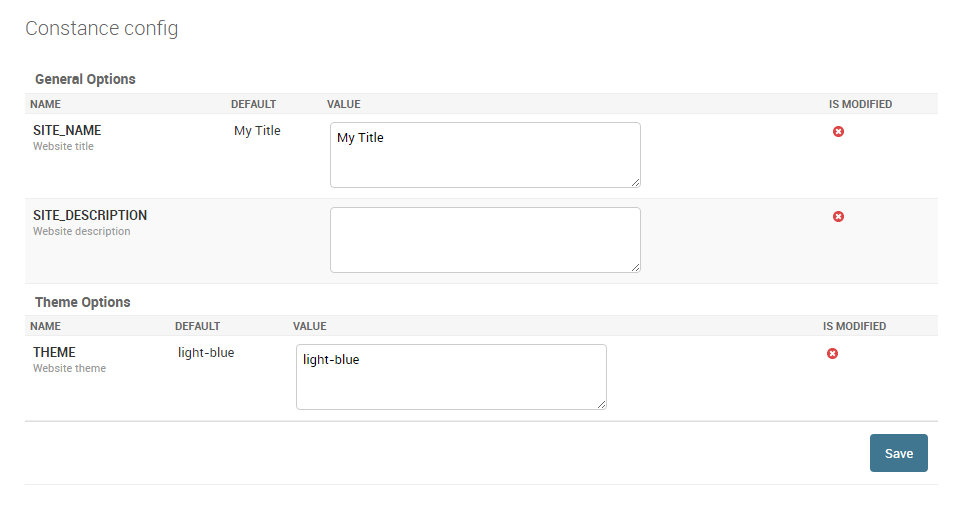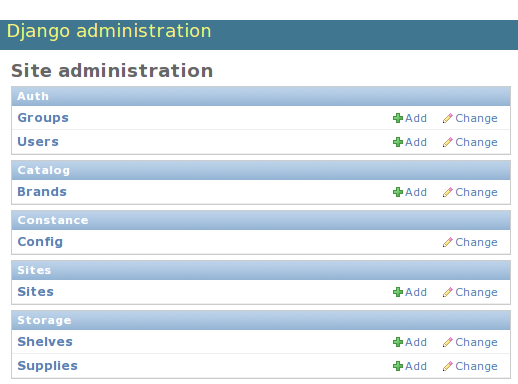Constance - Dynamic Django settings¶
Features¶
- Easily migrate your static settings to dynamic settings.
- Edit the dynamic settings in the Django admin interface.

Quick Installation¶
For complete installation instructions, including how to install the database backend, see Backends.
Configuration¶
Modify your settings.py. Add 'constance' to your
INSTALLED_APPS, and move each key you want to turn dynamic into
the CONSTANCE_CONFIG section, like this:
INSTALLED_APPS = (
'django.contrib.admin',
'django.contrib.staticfiles',
'django.contrib.auth',
'django.contrib.contenttypes',
'django.contrib.sessions',
'django.contrib.messages',
...
'constance',
)
CONSTANCE_CONFIG = {
'THE_ANSWER': (42, 'Answer to the Ultimate Question of Life, '
'The Universe, and Everything'),
}
Note
Add constance before your project apps.
Note
If you use admin extensions like
Grapelli, 'constance' should be added
in INSTALLED_APPS before those extensions.
Here, 42 is the default value for the key THE_ANSWER if it is
not found in the backend. The other member of the tuple is a help text the
admin will show.
See the Backends section how to setup the backend and finish the configuration.
django-constance’s hashes generated in different instances of the same
application may differ, preventing data from being saved.
Use CONSTANCE_IGNORE_ADMIN_VERSION_CHECK in order to skip hash
verification.
CONSTANCE_IGNORE_ADMIN_VERSION_CHECK = True
Signals¶
Each time a value is changed it will trigger a config_updated signal.
from constance.signals import config_updated
@receiver(config_updated)
def constance_updated(sender, key, old_value, new_value, **kwargs):
print(sender, key, old_value, new_value)
The sender is the config object, and the key and new_value
are the changed settings.
Custom fields¶
You can set the field type with the third value in the CONSTANCE_CONFIG tuple.
The value can be one of the supported types or a string matching a key in your :setting:CONSTANCE_ADDITIONAL_FIELDS
The supported types are:
boolintfloatDecimalstrdatetimedatetime
For example, to force a value to be handled as a string:
'THE_ANSWER': (42, 'Answer to the Ultimate Question of Life, '
'The Universe, and Everything', str),
Custom field types are supported using the dictionary :setting:CONSTANCE_ADDITIONAL_FIELDS.
This is a mapping between a field label and a sequence (list or tuple). The first item in the sequence is the string path of a field class, and the (optional) second item is a dictionary used to configure the field.
The widget and widget_kwargs keys in the field config dictionary can be used to configure the widget used in admin,
the other values will be passed as kwargs to the field’s __init__()
Note: Use later evaluated strings instead of direct classes for the field and widget classes:
CONSTANCE_ADDITIONAL_FIELDS = {
'yes_no_null_select': ['django.forms.fields.ChoiceField', {
'widget': 'django.forms.Select',
'choices': ((None, "-----"), ("yes", "Yes"), ("no", "No"))
}],
}
CONSTANCE_CONFIG = {
'MY_SELECT_KEY': ('yes', 'select yes or no', 'yes_no_null_select'),
}
If you want to work with images or files you can use this configuration:
CONSTANCE_ADDITIONAL_FIELDS = {
'image_field': ['django.forms.ImageField', {}]
}
CONSTANCE_CONFIG = {
'LOGO_IMAGE': ('default.png', 'Company logo', 'image_field'),
}
When used in a template you probably need to use:
{% load static %}
{% get_media_prefix as MEDIA_URL %}
<img src="{{ MEDIA_URL }}{{ config.LOGO_IMAGE }}">
Images and files are uploaded to MEDIA_ROOT by default. You can specify a subdirectory of MEDIA_ROOT to use instead by adding the CONSTANCE_FILE_ROOT setting. E.g.:
MEDIA_ROOT = os.path.join(BASE_DIR, 'media')
CONSTANCE_FILE_ROOT = 'constance'
This will result in files being placed in media/constance within your BASE_DIR. You can use deeper nesting in this setting (e.g. constance/images) but other relative path components (e.g. ../) will be rejected.
Ordered Fields in Django Admin¶
To sort the fields, you can use an OrderedDict:
from collections import OrderedDict
CONSTANCE_CONFIG = OrderedDict([
('SITE_NAME', ('My Title', 'Website title')),
('SITE_DESCRIPTION', ('', 'Website description')),
('THEME', ('light-blue', 'Website theme')),
])
Fieldsets¶
You can define fieldsets to group settings together:
CONSTANCE_CONFIG = {
'SITE_NAME': ('My Title', 'Website title'),
'SITE_DESCRIPTION': ('', 'Website description'),
'THEME': ('light-blue', 'Website theme'),
}
CONSTANCE_CONFIG_FIELDSETS = {
'General Options': ('SITE_NAME', 'SITE_DESCRIPTION'),
'Theme Options': ('THEME',),
}
Note
CONSTANCE_CONFIG_FIELDSETS must contain all fields from CONSTANCE_CONFIG.

Fieldsets collapsing¶
To make some fieldsets collapsing you can use new format in CONSTANCE_CONFIG_FIELDSETS. Here’s an example:
CONSTANCE_CONFIG = {
'SITE_NAME': ('My Title', 'Website title'),
'SITE_DESCRIPTION': ('', 'Website description'),
'THEME': ('light-blue', 'Website theme'),
}
CONSTANCE_CONFIG_FIELDSETS = {
'General Options': {
'fields': ('SITE_NAME', 'SITE_DESCRIPTION'),
'collapse': True
},
'Theme Options': ('THEME',),
}
Field internationalization¶
Field description and fieldset headers can be integrated into Django’s
internationalization using the gettext_lazy function. Note that the
CONSTANCE_CONFIG_FIELDSETS must be converted to a tuple instead of dict
as it is not possible to have lazy proxy objects as dictionary keys in the
settings file. Example:
from django.utils.translation import gettext_lazy as _
CONSTANCE_CONFIG = {
'SITE_NAME': ('My Title', _('Website title')),
'SITE_DESCRIPTION': ('', _('Website description')),
'THEME': ('light-blue', _('Website theme')),
}
CONSTANCE_CONFIG_FIELDSETS = (
(
_('General Options'),
{
'fields': ('SITE_NAME', 'SITE_DESCRIPTION'),
'collapse': True,
},
),
(_('Theme Options'), ('THEME',)),
)
Usage¶
Constance can be used from your Python code and from your Django templates.
Python¶
Accessing the config variables is as easy as importing the config object and accessing the variables with attribute lookups:
from constance import config
# ...
if config.THE_ANSWER == 42:
answer_the_question()
Django templates¶
To access the config object from your template you can pass the object to the template context:
from django.shortcuts import render
from constance import config
def myview(request):
return render(request, 'my_template.html', {'config': config})
You can also use the included context processor.
Insert 'constance.context_processors.config' at
the top of your TEMPLATES['OPTIONS']['context_processors'] list. See the
Django documentation for details.
This will add the config instance to the context of any template
rendered with a RequestContext.
Then, in your template you can refer to the config values just as any other variable, e.g.:
<h1>Welcome on {{ config.SITE_NAME }}</h1>
{% if config.BETA_LAUNCHED %}
Woohoo! Head over <a href="/sekrit/">here</a> to use the beta.
{% else %}
Sadly we haven't launched yet, click <a href="/newsletter/">here</a>
to signup for our newletter.
{% endif %}
Command Line¶
Constance settings can be get/set on the command line with the manage command constance
Available options are:
list - output all values in a tab-separated format:
$ ./manage.py constance list
THE_ANSWER 42
SITE_NAME My Title
get KEY - output a single values:
$ ./manage.py constance get THE_ANSWER
42
set KEY VALUE - set a single value:
$ ./manage.py constance set SITE_NAME "Another Title"
If the value contains spaces it should be wrapped in quotes.
Note
Set values are validated as per in admin, an error will be raised if validation fails:
E.g., given this config as per the example app:
CONSTANCE_CONFIG = {
...
'DATE_ESTABLISHED': (date(1972, 11, 30), "the shop's first opening"),
}
Setting an invalid date will fail as follow:
$ ./manage.py constance set DATE_ESTABLISHED '1999-12-00'
CommandError: Enter a valid date.
Note
If the admin field is a MultiValueField, then the separate field values need to be provided as separate arguments.
E.g., a datetime using SplitDateTimeField:
CONSTANCE_CONFIG = {
'DATETIME_VALUE': (datetime(2010, 8, 23, 11, 29, 24), 'time of the first commit'),
}
Then this works (and the quotes are optional):
./manage.py constance set DATETIME_VALUE '2011-09-24' '12:30:25'
This doesn’t work:
./manage.py constance set DATETIME_VALUE '2011-09-24 12:30:25'
CommandError: Enter a list of values.
remove_stale_keys - delete all stale records in database:
$ ./manage.py constance remove_stale_keys
Record is considered stale if it exists in database but absent in config
Editing¶
Fire up your admin and you should see a new app called Constance
with THE_ANSWER in the Config pseudo model.
By default, changing the settings via the admin is only allowed for superusers.
To change this, feel free to set the CONSTANCE_SUPERUSER_ONLY
setting to False and give users or user groups access to the
constance.change_config permission.

The virtual application Constance among your regular applications.
Custom settings form¶
If you aim at creating a custom settings form this is possible in the following
way: You can inherit from ConstanceAdmin and set the form property on
your custom admin to use your custom form. This allows you to define your own
formsets and layouts, similar to defining a custom form on a standard
Django ModelAdmin. This way you can fully style your settings form and group
settings the way you like.
from constance.admin import ConstanceAdmin, Config
from constance.forms import ConstanceForm
class CustomConfigForm(ConstanceForm):
def __init__(self, *args, **kwargs):
super().__init__(*args, **kwargs)
#... do stuff to make your settings form nice ...
class ConfigAdmin(ConstanceAdmin):
change_list_form = CustomConfigForm
change_list_template = 'admin/config/settings.html'
admin.site.unregister([Config])
admin.site.register([Config], ConfigAdmin)
You can also override the get_changelist_form method which is called in
changelist_view to get the actual form used to change the settings. This
allows you to pick a different form according to the user that makes the
request. For example:
class SuperuserForm(ConstanceForm):
# Do some stuff here
class MyConstanceAdmin(ConstanceAdmin):
def get_changelist_form(self, request):
if request.user.is_superuser:
return SuperuserForm:
else:
return super().get_changelist_form(request)
Note that the default method returns self.change_list_form.
More documentation¶
- Backends
- Testing
- Changelog
- v3.1.0 (2023/08/21)
- v3.0.0 (2023/07/27)
- v2.9.1 (2022/08/11)
- v2.9.0 (2022/03/11)
- v2.8.0 (2020/11/19)
- v2.7.0 (2020/06/22)
- v2.6.0 (2020/01/29)
- v2.5.0 (2019/12/23)
- v2.4.0 (2019/03/16)
- v2.3.1 (2018/09/20)
- v2.3.0 (2018/09/13)
- v2.2.0 (2018/03/23)
- v2.1.0 (2018/02/07)
- v2.0.0 (2017/02/17)
- v1.3.4 (2016/12/23)
- v1.3.3 (2016/09/17)
- v1.3.2 (2016/09/17)
- v1.3.1 (2016/09/15)
- v1.3 (2016/09/14)
- v1.2.1 (2016/09/1)
- v1.2 (2016/05/14)
- v1.1.2 (2016/02/08)
- v1.1.1 (2015/10/01)
- v1.1 (2015/09/24)
- v1.0.1 (2015/01/07)
- v1.0 (2014/12/04)
- v0.6 (2013/04/12)
- v0.5 (2013/03/02)